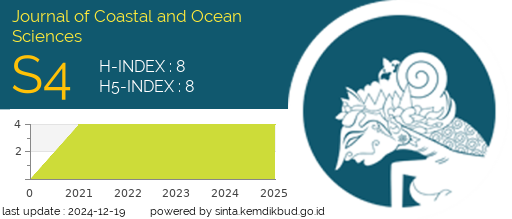Identification of Indigenous Bacteria from Dumai Sea Waters Using 16S rRNA Method
DOI:
https://doi.org/10.31258/Keywords:
Indigenous bacteria 16S rRNA Phylogenic B.paramycoidesAbstract
Indigenous bacteria are bacteria that naturally live freely in nature and have a variety of benefits for humans. These bacteria also have the potential to degrade pollution bacteria in the water. This research was conducted in November-December 2020. The purpose of this study was to and identify indigenous bacteria from dumai sea waters using the PCR method of 16S rRNA sequence technique. Based on the results of the study based on the analysis of 16S rRNA it is known that isolate 10 belongs to the bacterium genus Bacillus and has a homological rate of 93% with Bacillus paramycoides bacteria. Based on the phylogenic tree of isolate bacteria 10 does not have nodes associated with ten bacteria contained in NCBI. This suggests that phylogenically indigenous bacteria ISL 10 have no species similarity to the ten bacterial isolates in the phylogenetic tree, but have a similarity of base order of 93% to B. paramycoides.
Downloads
References
Drancourt, M. A. Carlioz., C. Bollet dan D. Roult. (2000). 16S Ribosomal DNA Sequene Analysis of a Large Collection of Enviromental and Clinic Unidentifiable Bacterial Isolates. J. Clin Microbial. 38: 3623-3630
Feliatra, F., T. Nugroho, T. Silalahi, dan S.Y. Oktavia. (2011). Skrining Bakteri Vibrio sp Asli Indonesia sebagai Penyenbab Penyakit Udang Berbasis Teknik 16S Ribosomal DNA. Jurnal Ilmu dan Teknologi Kelautan Tropis. 3(2): 85-99.
Reimena, R. (2016). Isolasi dan Identifikasi Bakteri Asam Laktat genus Pediocoocus sp dari Feses Orang Sumatra (Pongo abelii). Skripsi. Fakultas Kedokteran Hewan. Universitas Syiah Kuala.
Rizaldi, R., W. H. Setyantini dan Sudarno. (2018). Isolasi dan Karakterisasi Bakteri Proteolitik yang Berasosiasi dengan Lamun (Enhalus acoroides) di Pantai Bama, Taman Nasional Baluran, Situbondo, Jawa Timur. Departemen Manajemen Kesehatan Ikan dan Akuakultur, Fakultas Perikanan dan Kelautan Universitas Airlangga. 10 (1).
Rochman, C.M., A. Tahir, S.L. Williams, D.V. Baxa, R. Lam, dan J.T. Miller. (2016). Anthropogenic debris in seafood: Plastic debris and fibers from textiles in fish and bivalves sold for human consumption. J. Nature. 15(32): 77-97.
Sogandi. (2018). Biologi Molekuler Identifikasi Secara Molekuler. Jakarta: Garuda
Tamura, K., A. Filipski, D. Peterson, G. Stecher, dan S. Kumar. (2013). MEGA (Molecular Evolutionary Genetics Analysis) software versi 6.0: Mol. Bio and Evol. 30:2725-2729.
Tanasupawat, M. K., M. Shahnawaz, dan A. B. Ade. (2016). A Review on Biodegradation of Polythene: The Microbial Approach. J Bioremed Biodeg. 3(10): 1-9.
Waluyo, L. (2007). Mikrobiologi Umum. Penerbit Universitas Muhammadiyah. Press Malang.
Waluyo, L. (2018). Teknik Metode Dasar dalam Mikrobiologi. Penerbit Universitas Muhammadiyah. Press Malang






